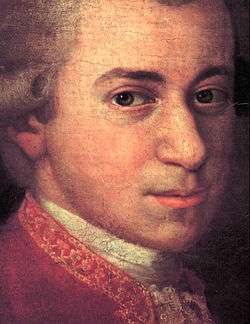Oboe Quartet (Mozart)
The Oboe Quartet in F major, K. 370/368b, was written by Wolfgang Amadeus Mozart in early 1781. The quartet is scored for oboe, violin, viola and cello. In 1780, Mozart was invited to Munich to visit Elector Karl Theodor, who had commissioned the opera Idomeneo for a carnival celebration.[1] While in Munich, Mozart renewed an acquaintance with Friedrich Ramm, a virtuoso oboist in the Munich orchestra. It was for Ramm that Mozart composed the quartet in order to show off his virtuosity and the improvements that had been made to the oboe at that time.[1] One way that this piece showed off the instrument was the use of the "high F" above the staff, a note rarely played in any repertoire previously written for the oboe.[2]
This piece is a work of chamber music, but it has elements that harken to other musical genres, and requires a fair amount of virtuosity. Because of its large amount of virtuosic playing on the part of the oboe and the large degree to which the strings simply accompany the oboist, it almost resembles a concerto, but with only with four players instead of an entire orchestra. Despite this, there are also a number of places within the work that require ensemble playing, for example, the famous 13-bar passage in the finale in which the oboe plays in common time against a 6/8 accompaniment.[2][3][4]
Structure

There are three movements:
An average performance takes around 15 minutes.
Media
 |
Oboe Quartet in F major, K. 370
1. Allegro
2. Adagio
|
| Problems playing these files? See media help. | |
References
- Notes
- 1 2 Berger 2001, p. 284–285
- 1 2 Gylgayton & Way 1999
- ↑ Bromberger 2012
- ↑ Odom 2001, p. 2
- Sources
- Berger, Melvin (2001). Guide to Chamber Music. Mineola, New York: Dover. ISBN 0-486-41879-0.
- Bromberger, Eric (2012). "Brilliant Beginnings". Chamber Music Northwest. Chamber Music Northwest. Retrieved 29 October 2014.
- Gylgayton, Richard (1999). "Sierra Chamber Society Program Notes". Sierra Chamber Society. Joseph Way. Retrieved 29 October 2014.
- Odom, Sally (2001). Mozart: Oboe Quartet, Horn Quintet (PDF) (CD). Hyperion Records. CDH55390. Retrieved 22 November 2014.
External links
- Quartett in F für Oboe, Violine, Viola und Violoncello: Score and critical report (German) in the Neue Mozart-Ausgabe
- Oboe Quartet, K. 370: Scores at the International Music Score Library Project
- "WOLFGANG AMADEUS MOZART:Quartet in F Major for Oboe and Strings, K.370 - Program notes". La Jolla Music Society. Retrieved May 2013. Check date values in:
|access-date=(help) - Anderson, Keith (1992). Mozart: Oboe Quartet, K. 370 / Horn Quintet, K. 407 / A Musical Joke, K. 522, Naxos (CD). Naxos Records. 8.550437. Retrieved May 2013. Check date values in:
|access-date=(help) - Buttall, Philip R (2006). "Program notes to a performance of the Quartet by the Endellion String Quartet & David Walter" (PDF). Retrieved May 2013. Check date values in:
|access-date=(help) - Darwin, Chris. "Mozart: Oboe Quartet" (PDF). Retrieved May 2013. Check date values in:
|access-date=(help) - Gallant, Thomas (2013). "W.A. Mozart - Oboe Quartet in F Major, K. 370" (PDF). Retrieved May 2013. Check date values in:
|access-date=(help) - Hogwood, Christopher (21 February 2012). "Is it possible? - Mozart's Oboe Quartet in F major, K.370". Gresham College. Retrieved May 2013. Check date values in:
|access-date=(help) - Pajot, Dennis (2007). "K370/368a The Oboe Quartet in F". Retrieved May 2013. Check date values in:
|access-date=(help) - Siegel, Steve (19 January 2012). "Bewitching old and new music featuring clarinet". The Morning Call. Retrieved February 2015. Check date values in:
|access-date=(help)
